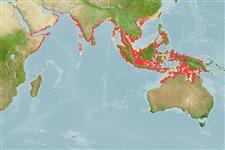Classification / Names
Common names from other countries
Main reference
Size / Weight / Age
Max length : 35.0 cm TL male/unsexed; (Ref. 11228); common length : 16.5 cm SL male/unsexed; (Ref. 188)
Length at first maturity
Lm 15.0 range ? - ? cm
Environment
Marine; freshwater; brackish; pelagic-neritic; anadromous (Ref. 51243); depth range 10 - ? m (Ref. 30573)
Climate / Range
Tropical, preferred 28°C (Ref. 107945); 25°N - 18°S, 43°E - 155°E (Ref. 54554)
Distribution
Indo-West Pacific: probably all coasts of Indian Ocean, from Gulf of Oman and Gulf of Aden south to Transkei, South Africa and Madagascar, across the Bay of Bengal, Gulf of Thailand, Java Sea and north to Hong Kong and east to Papua New Guinea and possibly further.
Countries | FAO areas | Ecosystems | Occurrences | Introductions
Short description
Dorsal
spines
(total): 0;
Dorsal
soft rays
(total): 16-19;
Anal
spines: 0;
Anal
soft rays: 21 - 23. Top of head with numerous fronto-parietal striae; upper jaw with median notch. gill rakers about 100 to 175, those on inner arches distinctly curled; outer row of gill filaments on first arch not more than half length of gill rakers. A series of small triangular scales above axil of pectoral fin; hind part of body scales perforated. A black spot behind gill opening; usually 10 along flank.
IUCN Red List Status (Ref. 115185)
Threat to humans
Harmless
Human uses
Fisheries: highly commercial; bait: occasionally
More information
ReferencesAquacultureAquaculture profileStrainsGeneticsAllele frequenciesHeritabilityDiseasesProcessingMass conversion
Tools
Special reports
Download XML
Internet sources
Estimates of some properties based on models
Phylogenetic diversity index
PD50 = 1.0000 many relatives (e.g. carps) 0.5 - 2.0 few relatives (e.g. lungfishes)
Trophic Level
2.9 ±0.33 se; Based on food items.
Resilience
High, minimum population doubling time less than 15 months (K=1.1)
Vulnerability
Low vulnerability (18 of 100)
Price category
